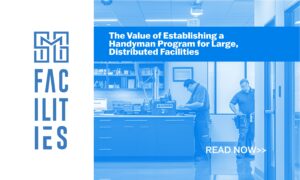How does a business owner determine the appropriate facilities management benchmarking metrics that they should monitor and track? And more importantly, what constitutes facility maintenance and management metrics KPIs? Getting back to basics, KPIs represent specific data sets, reflecting how successful a particular process or procedure remains an asset to an organization. In facilities management, these track just about any function, design, or event surrounding maintenance, the management of the building, or other activities. The key to intelligent use of facilities management performance metrics is to select the proper KPIs. Let’s look at the top facility management metrics and KPIs you should be tracking to improve efficiency and do more with less.
Facilities Management Performance Metrics Must Start With Real Data
One of the most common issues with tracking facility management metrics rests with stale or outdated data. All facilities management benchmark metrics must reflect real-world situations and stay based on validated data collected from the computerized maintenance management system (CMMS), connected facility assets, historical repair and maintenance (R&M) and field service data.
Track Work Order Response Times & Breakdown (Urgent) Response Times
Time equals money, so work order response times are among the leading metrics to time. Tracking response times is also essential to avoid worsening the maintenance backlog, and in an industry struggling to find and retain talent, more organizations are turning to outsourcing. In addition to faster response times, outsourcing facilities maintenance and management can yield 15% ROI upon implementation with added ROI possible after a few short months, reports McKinsey & Company. Specifically, approximately 20% of all integrated facility management needs are outsourced in North America. If you’re not outsourcing, you are in the majority while likely losing money without realizing it. To track this leader of facilities management metrics, use this calculation.
Average Order Response Time = Total Time Between Reporting an Issue and Its Correction / Total Number of Work Orders
There’s another urgent or emergency need response time metric to track as well. Remember that work orders can include any number of potential needs, such as rewaxing a floor, while breakdown response time should have a much shorter duration.
Many problems exist that can disrupt facility management teams. Tracking how much time passes between repairs for similar systems and equipment can also provide valuable data and insight to facility managers. Additionally, the amount of time between repairs needed on a specific and individual unit or system can also show valuable data about operations and usage. As the time between repair work decreases, it highlights a possible need to upgrade the unit, do some in-depth maintenance work, or rework a system entirely to be more efficient and reliable.
Track the Backlog of Deferred Maintenance
A maintenance backlog might not always be possible to avoid. Still, the time a repair spends on the backlog and the costs associated with deferred maintenance is another of the leading facility management KPIs to track.
Remember that deferred maintenance often occurs as an attempt to save money and stretch the budget further. In the short term, this might work, but those delayed repairs and upkeep can cause major issues and failures in time. As a rule of thumb, deferred maintenance costs will eventually become the squared value of the original repair, meaning a $100 repair becomes a $10,000 repair if left unattended.
For example, a leaking HVAC drain line might seem nominal, but water damage caused by the original issue can quickly lead to significant problems. This can lead to even greater expenses, extended downtimes, and an increased potential for injuries and damages, and the risk for mold growth or illness among building occupants.
The calculation of this essential facility management benchmarking metric is simply a running average of backlog needs for a set period. However, the calculation for the anticipated cost of item placed on the backlog or listed as deferred maintenance is as follows:
Total Cost of Deferred, Backlogged Needs = Original Cost of Repair * Original Cost of Repair
Planned Versus Reactive Maintenance Costs
The percentage of planned versus reactive maintenance represents another critical metric that your team should track. This KPI comes by dividing the scheduled maintenance cost by the amount spent on urgent on-demand work.
The metric results can help shed light on areas that require more maintenance or that experience breakdowns more often than usual or expected. Top priorities, including repairs to plumbing, elevator systems, security systems, and electrical systems, are typical examples of these problem areas. Regardless
Planned Versus Reactive Ratio of Maintenance = Planned Maintenance Costs / Reactive Maintenance Costs
Now, there are many ways to apply this metric or to calculate the difference. For instance, a reactive divided by planned maintenance cost * 100 can provide a percentage of the amount of maintenance that has been reactive for a given reporting period. However, the above calculation makes it a bit easier. If the result is ever anything other than 0, it indicates reactive maintenance occurred. This makes it easier to see which periods required reactive, urgent, or on-demand service. Using the calculation in bold, as the result increases, it indicates the growth of reactive maintenance needs compared to planned maintenance.
Energy Use Variations Within Asset/Unit
Like tracking time between maintenance and repairs, the energy use per asset or unit may also highlight potential issues. Most mechanical systems and facility equipment, such as HVAC systems, see a spike in energy usage before a major failure or breakdown. Increases in energy consumption or decreased energy efficiency within the unit itself often mean something is wrong with the device, unit, or system that needs addressing. It also allows for better facility asset management for both short-term and long-term needs.
Energy Use Variation = Expected Energy Use Based on Runtime / Total Energy Used
Average Costs Incurred Per Repair Work Order
Tracking time spent per work order can assist with overall budgeting and spending on facilities management. Decreasing each work order cost helps lower expenses, but reducing work order numbers overall serves as an even better goal for management teams. Facility management metrics or KPIs work best to track the cost per work order rather than getting bogged down in the details of trying to follow the exact number of submitted work orders per quarter.
Average Cost Per Work Order = Total Cost of Repairs / Total Number of Work Orders
Start Tracking the Right Facility Management Metrics by Choosing the Right Partner
For facilities management metrics to translate into practical and applicable KPIs, facility managers must track and record the most accurate and valuable data and make it “actionable”. Instead of getting weighed down with the details of determining which metrics to follow and what data to track and what information to pay attention to, let the experts take care of it for you. Contact SMG Facility Services today to get started!







